1. About the practice of small regular script
1. When studying "Declaration Form", you should grasp its artistic features such as its large and clumsy fonts, quaint and simple dot paintings, and its clear and simple charm. Use the pen to fall lightly and draw it back gently, and take the horizontal momentum of the structure. The key is to grasp the overall characteristics of Xiaokai, which is "sparse, clear, even, wide and wide enough".
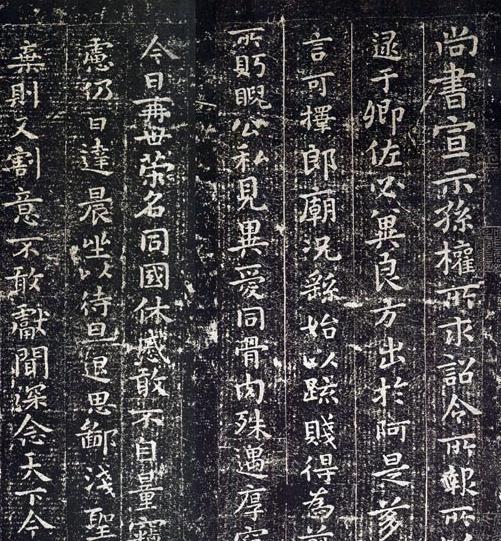
Picture/Zhong Yao’s declaration form, part
2. Small regular script generally belongs to Tie Xue. If we can take into account the style of writing in the Han and Wei dynasties and the straightforwardness of Dunhuang sutra writing, it will increase the meaning of the writing style.
3. The writing style of small regular script is particularly exquisite, which requires that the contradictory unity of "clear" and "fat" be properly handled. "Qing" means that the ink is not loose and the hair is sharp; "Fu" means that the writing style is subtle and the writing force is plump. If it is also clear and plump, the bones and blood will be warm and moist, mellow and harmonious, and it can be considered the ancients. If you want small characters to have a grand atmosphere, you must emphasize the style of ink. It must be heavy and heavy, and the key points and strokes must be clear to write new ideas.
4. To achieve "small characters should be like big characters", in addition to writing in a clear, even and wide manner, as Mr. Gao Ershi said, small characters should have more ink, the handwriting should be clear, and if there is a hair, it should be written in all directions. All ink.
5. Small regular script and large regular script are very different. Large regular script starts with the stipple requirements, while small regular script focuses on knotting. Small regular script is so small that the direction of each stroke and the distance between strokes are sometimes not spaced. It is not easy to require each stroke to have a posture. If you want to make many changes in strokes, wrist movement is important. Mr. Gao Ershi said, "Small regular script is also purely about movement of the wrist. Once fingering is involved, it cannot be achieved." Therefore, when practicing, you should strive to improve your wrist movement, make the ups and downs clear, and try your best to control the technique of not fake fingering.
6. Small characters and large characters are completely different and cannot be regarded as enlargement or reduction of each other. Large characters are easy to be indulged in. If they are excessive or blindly indulged, they will become frivolous and loose, without the interest of profoundness and calmness. Therefore, large characters should be placed in the middle and restrained; It will also be lost due to lightness, so small characters should be restrained but released. It can be seen from this that there is a qualitative difference between the two and should be carefully considered when writing.
2. About the copywriting of official script and official script
1. If you like big calligraphy and formal calligraphy, you can learn Yan style, such as "Yan Qinli Stele"; or Wei steles, such as "Zhang Menglong Stele", "Yang Dayan Stele", "Zheng Wengong Stele", etc.
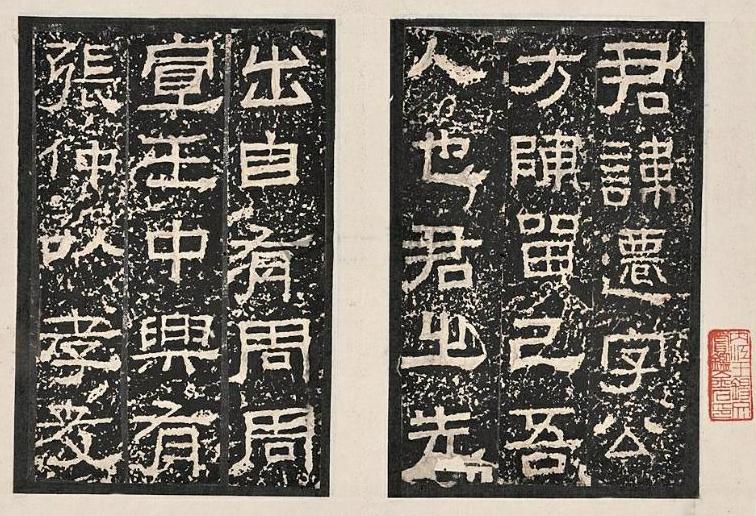
Picture/Zhang Qian’s stele, detail
2. When studying "Zhang Qian Stele", you should pay attention to the natural and smooth strokes of the pen (stippling) and try to avoid trembling and affectation. To see the edge of the pen through the edge of the knife, there is no need to deliberately pursue the effect that appears due to the erosion of the lines and edges of the knife over time.
3. Zhiyong's regular script "Thousand-Character Classic" has always been considered a unique and better copying model. During the practice, one can be familiar with both regular script and cursive script. The practice of regular script will automatically integrate the emotion of the cursive script, and it will have the effect of Kill two birds with one stone.
4. When studying "Cao Quan", it is not easy to write the feminine beauty characterized by mellowness, relaxation, elegance and elegance. The folding method of this post is mainly round transfer pen, and some of the pens are broken but the meaning is connected. Specifically speaking, most of the brush strokes are made by turning from inside to dark, and the wave painting is done by rising and dragging backwards and forwards in the middle to make an arc-shaped tip, rather than folding the pen and applying it sideways.
3. About the practice of running script
1. When learning running script, it is advisable to copy the Preface to the Holy Teachings. It is necessary to grasp the artistic style and characteristics of this post, such as the smooth and elegant brushwork, the graceful and graceful writing style, the gentle and light breath, etc. The pen is tucked and convergent, the lines are thin, hard and strong, the combination of stipples, the radicals, and The silk threads, the strokes and the character movements are pure and natural. In the meantime, pay attention to correcting common problems such as slow and weak lines, such as weak bones, poor Qi, and sluggish ink. On the basis of Tonglin, it is necessary to fight a tough battle and pass the test word by word from aspects such as font type, font style, pen shape, stroke style and thickness contrast of strokes, ink color changes (refer to Lanting ink), etc. You need to work hard on memorizing fonts to achieve the proficiency of finding something in your pocket when creating works. The real level of a piece of work, or even the difference between an expert and an amateur in calligraphy, often depends on the smallest details. This is the so-called "the fiber is turned back, and the slightest hair is dead or alive". Therefore, when writing, you must pay special attention to details, including the position of strokes, the combination of thickness and length, the size of glyphs, the shade of ink, the relationship between strokes and glyphs, and the correspondence relationship, etc. Don't let go of even subtle changes in order to train and improve own eyesight. With the foundation of "Holy Teaching Preface", it will be much easier to learn "Lanting Preface", focusing on learning the composition, Qi and subtleties; then study Wang's Notes and learn how Wang Xizhi gave shape to characters and emotions. Plan and so on.
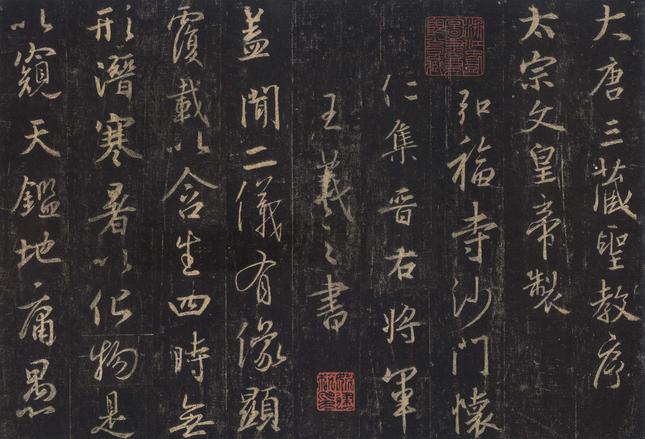
Picture/Holy Preface to Huairen's Collection of Words
2. In a sense, writing a calligraphy is the sum of the understanding and skill of the person writing the calligraphy. When copying a post, you must adhere to the combination of reading, copying, and copying. Read to get the interest. Through reading, you can deeply imprint the points, paintings, structure, momentum, structure and other characteristics in the model into your mind; copy to get the shape and the meaning of the words. The charm cannot be separated from the structure. On the basis of reading, you must concentrate on the handwriting and memorize the various fonts. Once you get the meaning, after two steps of hard work, you will be like a fish in water in this step. My own accumulation leads to quasi-creation.
3. The study of the penetration of "qi" and the generation of "shi" is of course related to the level of proficiency, but the key is to have this concept. Whether it is "reading", "linting" or "creating", whether you have this concept is It is quite different. You can find discussions on this aspect in ancient and modern treatises and read them carefully to understand.
4. Huang Tingjian's running calligraphy strokes are vertical and horizontal, with open stipples. Although it has a radiating structure, it is not loose; the body posture is slanted, but it does not tip over. "Songfeng Pavilion Poetry Volume" is his masterpiece in his later years, which fully reflects the above characteristics. When writing, you need to pay attention to the connotative beauty of "something in the pen" that Huang pursues, or the "qi and charm" that complement each other.
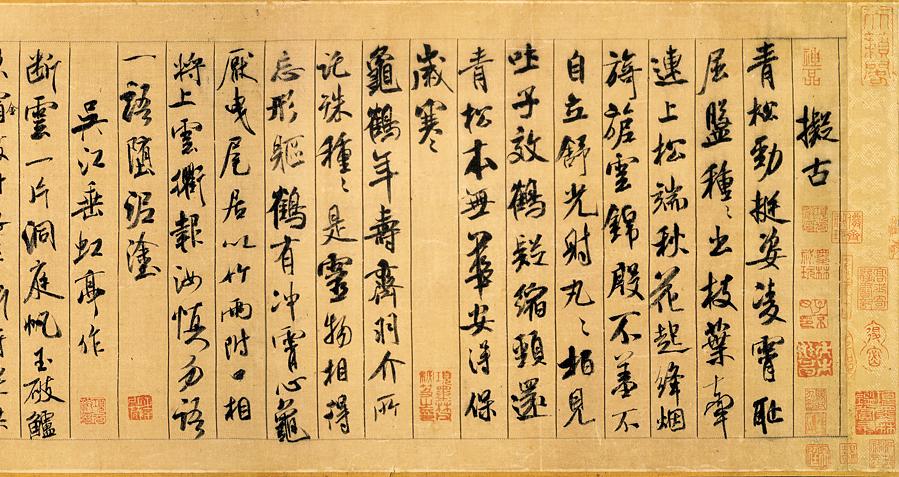
Picture/Shu Sutie, detail
5. The starting point for learning running script is Mi Fu's "Shu Su Tie". To prepare this calligraphy well, you must first understand the overall characteristics of Mi Fu's calligraphy, firmly grasp the artistic characteristics of this calligraphy, and then carefully study its brush use, structure, composition, and ink techniques one by one. In particular, the characteristics of pen use must be carefully studied, mastered, memorized, and able to use, and change one's own pen-using habits; the fonts must be memorized to the extent that they can be used proficiently when creating, and avoid just making general assumptions. Mi Fu has abundant wrist strength, unique brushstrokes, and moist and gorgeous brushwork. He pays great attention to the strength and posture of his brushwork. Strength is generated by relying on force, and force is manifested by force. Therefore, the strength of the bones is graceful and the writing force is smooth.
4. About the practice of cursive writing
1. Cursive script is divided into two categories: one is Zhangcao, which is the official script; the other is Jincao, which is the regular script and should be at the same level as running script. Kuangcao belongs to Jincao. If the running script means "walk", Xiaocao means "run" and Kuangcao means "running wildly". The current fashion for walking and running is also a style. Learning cursive script requires a certain foundation of orthodox script, because cursive script originates from orthodox (seal script and official) script, and at the same time, cursive script has the aesthetic quality of each script. Cursive script has strict requirements from calligraphy to stroke structure. Only by proceeding from shallow to deep, from easy to difficult, from ordinary to dangerous, step by step, and after long-term training in calligraphy and techniques can one truly master and learn this art. To attack big things, you should start from small things. You can first study Wang Xizhi's "Seventeen Posts", Zhiyong or Huaisu's "Thousand Character Essay", and Sun Guoting's "Book Book". Because various styles of Dacao are based on Xiaocao, if you have a certain foundation of Dacao, you can choose a Dacao work that suits your own aesthetic concepts as your own practice model. Because cursive writing has more meaning than law and is very emotional, so when practicing cursive writing, you also need to pay attention to the skills outside the words. Because writers often subconsciously express their aesthetics, accomplishments, and emotions in a moment of eloquence. The so-called "writing is like a person" is most fully expressed at this time, so it is even more important to improve artistic accomplishment when practicing cursive writing.
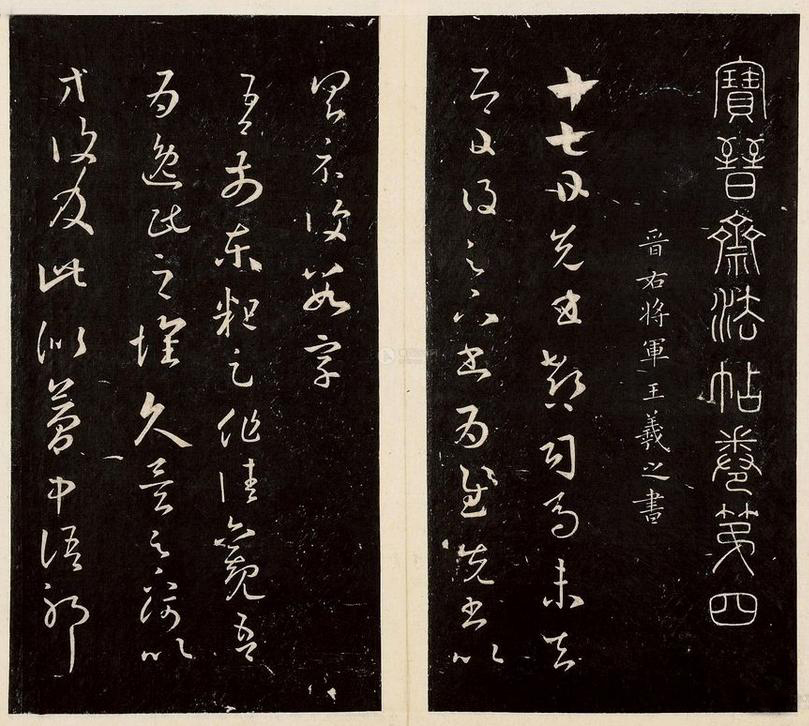
Picture/Wang Xizhi's seventeenth post, part
2. Wang Xizhi's regular script can be traced back to Zhong Yao, while his cursive script can be traced back to Zhang Zhi. His "Seventeen Posts" are written in cursive script using the real calligraphy method, and the cursive writing is as real as the real calligraphy. Therefore, the writing is charming, the structure is precise, and it seems simple, but you will know how difficult it is after you start writing. For this reason, it is recommended that: First, practice at a ratio of 1 to 1 or slightly larger, so that you can easily find gaps in the proofreading papers and correct them in a timely manner so as not to make mistakes again; secondly, you should pay attention to the tools, pen, ink, and paper to achieve the effect of the original postings. standard. It is better to use hard or mixed pens for the pen, and the paper can be Yuan calligraphy paper or half-baked gold-sprinkled Xuan paper. Third, carefully study the introductory articles and materials about the artistic characteristics of this post, so that you can use the pen and finish the words for this post. Have a deep understanding and grasp of technical and artistic characteristics such as composition, taste, etc.; fourth, it is important to observe the essence and to imitate it. Details are the life of art. In the process of analyzing and studying every detail (such as the start, line, and end of the pen, etc.), you must be good at discovering things that others have not discovered and collecting them in your own pen.
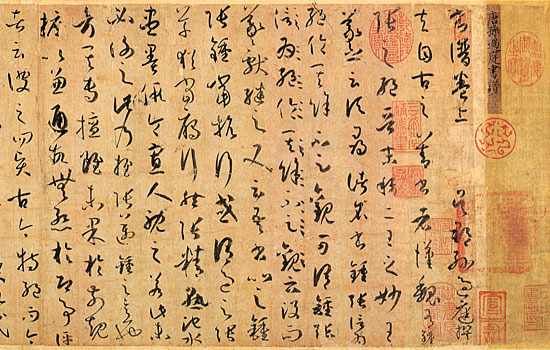
Sun Guoting's book genealogy, partial
3. "Book Book" has a large number of words and a clear path to completion, making it easy to follow the rules. When studying "Shu Pu", one should express the graceful and unrestrained style of the pen, as well as the vertical and horizontal smoothness, elegance and strength of the pen, especially the use of both the middle and side of the pen, clear lifting and pressing, and measured pauses and setbacks. The "worm effect" of texture and rhythm produced is particularly exquisite. Start writing "Book Book" and put the rest aside. You should concentrate on writing it seriously. You don't have to ask for quantity for the moment. Accuracy is the standard. You can choose a few words or words that are representative and that you think are wonderful. A few lines of calligraphy can be thoroughly analyzed and understood from the perspective of strokes, fonts, etc., and the style characteristics recognized can be vividly expressed with one's own pen. In this way, you can draw inferences from one instance, draw inferences from analogies, and expand the amount of accumulation until you are proficient in the entire calligraphy and can choose and write at will. Then you can get eighty-nine parts of the original calligraphy. At this point, your calligraphy skills will definitely be greatly improved. At this time, don’t worry about your weak personality. As long as you have this foundation, you will purposefully choose other classics and selectively absorb nutrients that can improve and enrich this style. Over time, your works will be both deeply traditional and interesting. Show your personality more obviously.
4. After you have mastered "Shu Pu", you will then study "Seventeen Posts". This post is designed to be convenient throughout, with almost no redundant writing, clean and clear, and other or future works are just based on this basis. of vertical and horizontal play. On this basis, we will return to Huaisu's "Autobiography" and Huang Tingjian's "Taibai's Reminiscences of Old Travels". Huaisu's cursive writing is extremely unrestrained without losing the rules, while Huang's cursive writing enhances the "point" method. With these foundations in mind, you might as well try out each of them and take advantage of their strengths to lay the foundation for future creations.
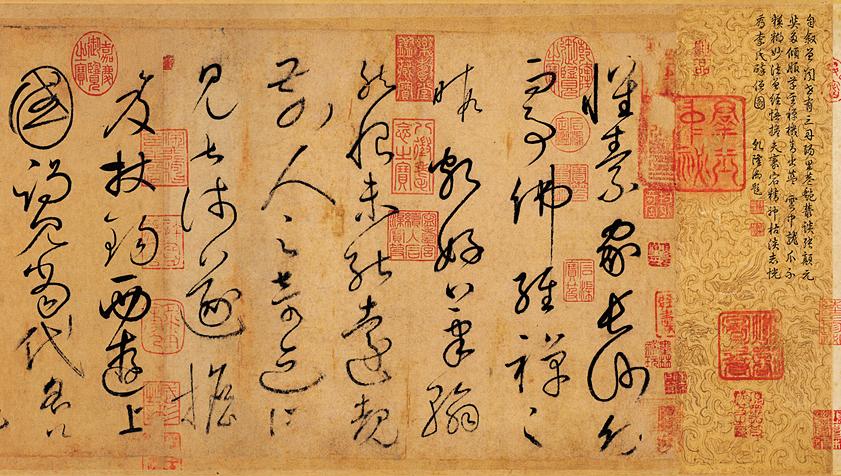
Picture/Huaisu's autobiography, part
5. Study Huaisu's "Autobiography Tie" and reflect the clean and healthy writing style, the round and vigorous lines shown by the thin and vigorous writing style, as well as the unrestrained and smooth body posture and the wanton and indulgent layout. The center is used from beginning to end in this post, and the strength is consistent throughout. The solid and strong line power generated by the stagnation of flow and the proper lifting and pressing must also be displayed.
6. Zhang Xu's "Four Posts on Ancient Poems" and "Tie on Belly Pain" are both his representative works. Compared with Huaisu's "Self-narrative Post", the stipples are thicker, and there are twists and turns, lifting and pressing, both middle and side strokes, and the brushstrokes are more powerful. Zongyi has a strong sense of rhythm with the white and white contrasting the virtual and the real. Some students have deficiencies in calligraphy, brushwork, composition, etc. during the study. Some parts of the brushwork are not clear, some are not in place, and some are overdone. The transition between the center and the side is unnatural, the lines are not solid enough, and the composition is not clear. Smooth, there are phenomena such as cow-topping and breathlessness, and the yielding relationship is not handled well, etc.
7. Cursive writing must have a certain momentum, accurate calligraphy, bold writing, dare to write freely, pay attention to the changes in ink color, and make the transition natural and rhythmic. Pay attention to prevent sloppy writing, unclear explanation of strokes, "over" or insufficient strokes, sluggish strokes, etc., especially when lifting the strokes at turning points. It is necessary to strengthen the copying of classic Dharma calligraphy, strengthen the training of calligraphy and techniques, strive for perfection in the atmosphere, and follow the path from raw to familiar, from familiar to skillful, from raw to raw, and from Dharma to intention.
8. When studying Wang Xizhi’s cursive handwriting, you must have an insight into the details, whether it is the font, calligraphy style, or pen shape, and be able to express it accurately. Especially for the expressive and "metaphysical" aspects of the post, it would be even more rare to have some insights and put them into writing. For example, the first three lines of "Kong Shi Zhong Tie" show a calmer state of mind in the writing style and the rhythm of each word. The writing style in the last two lines is obviously accelerated, and the rhythm of two consecutive words appears, which adds to the author's suspenseful mood. Deepening, the unique emotional rhythm of this post is formed, which should be observed in the eyes of the observer and reflected in the writing.
9. If you are aspiring to major in writing, you should also dabble in seal script, official script, and regular script to lay a certain foundation for formal script, from simple to profound, from easy to difficult, from ordinary to dangerous, and proceed step by step.
5. About the path of learning books
1. The creation of calligraphy requires a long-term process of accumulation, selection, integration, refinement and sublimation. What to learn, what to take, what to give up, how to refine and sublimate what you have learned, and finally how to Forge your own calligraphy language, all need to be carefully considered and studied, and explored in practice. The most taboo thing is not having a backbone, making random strokes here and there, and feeling confused. In the end, you can only wander outside the hall of calligraphy. The general experience is to first find a classic Dharma script (no matter what style of writing) that suits your personality and that you like very much, study it carefully, and become proficient in the family's Dharma, which is the so-called "establishing roots." With this foundation, when you dabble in hundreds of companies in the future, you will have a clear direction for your choices. Only by knowing how to take and give up can we refine. With this process, we will gradually mature.
2. The purpose of copying is that "those who observe are more refined, those who imitate are more valuable" is to completely change one's writing habits (some of which have become habits), and develop the good habit of "the pen does not move in vain, and the writing has a reason". Really learn the good things from ancient posts. In this way, with the accumulation of practice, you can learn the techniques and connotations contained in many classic copybooks to enrich yourself, and you will have the "internal skills" necessary to enter the art of calligraphy.
3. Learn the classic works of classic authors and learn good things that have been tested by history and are generally accepted as acceptable methods. For good templates, you should copy them with your hands and understand them with your heart, and you should think deeply about them, so that you can truly understand the wonderful way. You will naturally know the quality of other posts and even fake ones, and then choose the good ones and follow them. You should also read more books and articles on the basic theory of calligraphy, and study more ancient calligraphy and fine works by modern famous artists. You will gain a lot and improve quickly.
4. To combine the study of calligraphy history, you can refer to "Selected Papers on Calligraphy of the Past Dynasties" published by Shanghai Painting and Calligraphy Publishing House.








